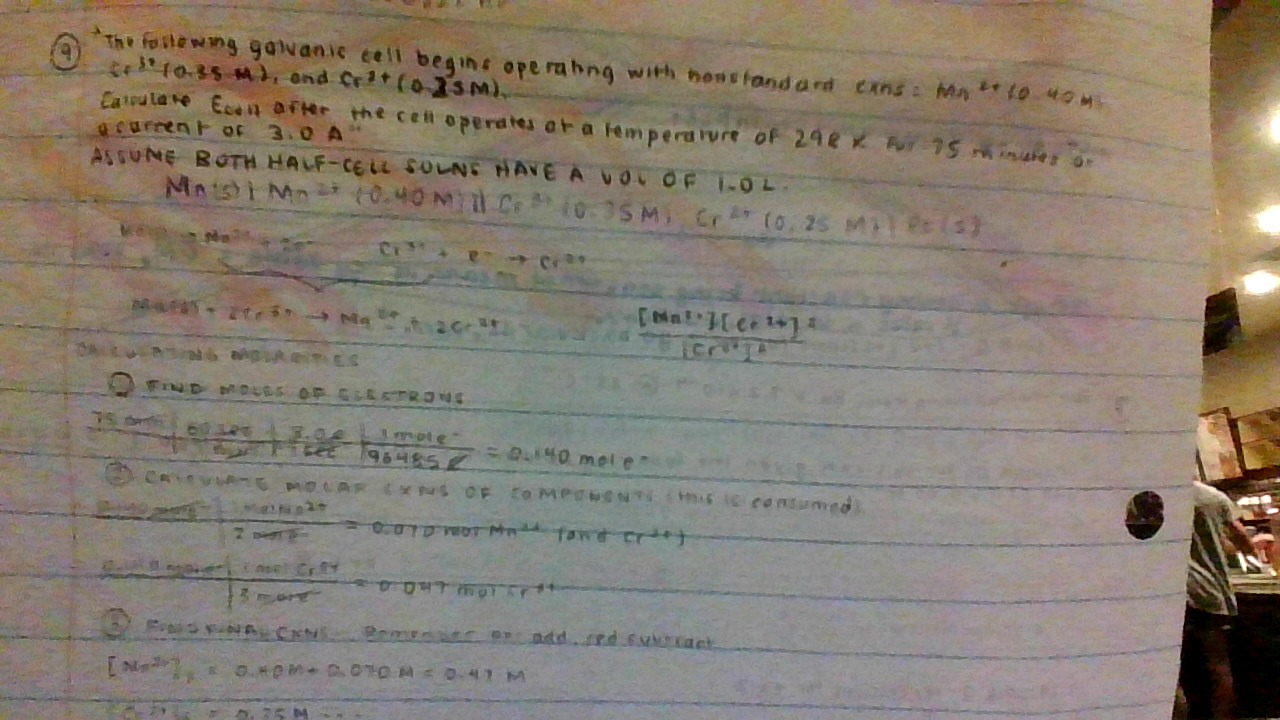Calculate #\sf{E_"cell"}# after the cell operates at a temperature of 298 K for 75 minutes at a current of 3.0 A?
Originally: "The following galvanic cell begins operating with nonstandard concentrations: #\tt{Mn^(2+)}# (0.40 M), #\tt{Cr^(3+)}# (0.35 M), and #\tt{Cr^(2+)}# (0.25 M)...
...Assume both half-cell solutions have a volume of 1.0 L."
I have calculated everything up to the consumed moles (and/or molar concentrations, given the volume of 1 liter), but I don't know how to calculate the final concentrations for either of the chromium ions ...
(warning: picture is likely to be unclear)

Originally: "The following galvanic cell begins operating with nonstandard concentrations:
...Assume both half-cell solutions have a volume of 1.0 L."
I have calculated everything up to the consumed moles (and/or molar concentrations, given the volume of 1 liter), but I don't know how to calculate the final concentrations for either of the chromium ions ...
(warning: picture is likely to be unclear)

1 Answer
Since it's a galvanic cell (voltaic cell), the desired reaction must be spontaneous by definition. So, we need the standard reduction potentials. TWO sources provide these:
WebAssign
Rezofthestory
#"Mn"^(2+)(aq) + 2e^(-) -> "Mn"(s)# ,#E_(red)^@ = -"1.18 V"#
#"Cr"^(3+)(aq) + e^(-) -> "Cr"^(2+)(aq)# ,#E_(red)^@ = -"0.50 V"#
My General Chemistry textbook (Tro) also reports
To form the spontaneous reaction, we require
#E_(cell)^@ = -"0.50 V" - (-"1.18 V")#
#= +"0.68 V"#
This means that we are placing
#overbrace("Mn"(s) | "Mn"^(2+)("0.40 M"))^"Anode" || overbrace("Cr"^(3+) ("0.35 M"), "Cr"^(2+) ("0.25 M") | "Pt"(s))^"Cathode"# (The inert electrode is required for the chromium side since no chromium metal is formed.)
and the reaction is:
#"Mn"(s) + 2"Cr"^(3+)(aq) -> 2"Cr"^(2+)(aq) + "Mn"^(2+)(aq)#
The cell will now operate (spontaneously) for
#75 cancel"min" xx (60 cancel"s")/cancel"1 min" xx "3.0 C"/cancel"s" xx ("1 mol e"^(-))/(96485 cancel"C")#
#= "0.1400 mols e"^(-)# are involved.
That means
-
#0.1400 cancel("mols e"^(-)) xx ("1 mol Mn"^(2+))/(2 cancel("mol e"^(-))) = "0.0700 mols Mn"^(2+)# is produced. -
#0.1400 cancel("mols e"^(-)) xx ("1 mol Cr"^(2+))/(1 cancel("mol e"^(-))) = "0.1400 mols Cr"^(2+)# is produced. -
#0.1400 cancel("mols e"^(-)) xx ("1 mol Cr"^(3+))/(1 cancel("mol e"^(-))) = "0.1400 mols Cr"^(3+)# is consumed.
When the cell starts to operate, it has
-
#"0.40 mols"/cancel"L" xx 1.0 cancel"L" = "0.40 mols Mn"^(2+)# -
#"0.25 mols"/cancel"L" xx 1.0 cancel"L" = "0.25 mols Cr"^(2+)# -
#"0.35 mols"/cancel"L" xx 1.0 cancel"L" = "0.35 mols Cr"^(3+)#
So, now it has...
#"Mn"(s) + 2"Cr"^(3+)(aq) -> 2"Cr"^(2+)(aq) + "Mn"^(2+)(aq)#
#"I"" "-" "" "" "0.35" "" "" "" "0.25" "" "" "0.40#
#"C"" "-" "" "-0.1400" "" "+0.1400" "+0.0700#
#"F"" "-" "" "" "0.21" "" "" "" "0.39" "" "" "0.47#
At this point we can calculate
#color(blue)(E_(cell)) = E_(cell)^@ - "0.0592 V"/n log Q#
#= "0.68 V" - "0.0592 V"/("2 mol e"^(-)//"1 mol Mn"^(2+)) log ((["Cr"^(2+)]^2["Mn"^(2+)])/(["Cr"^(3+)]^2))#
#= "0.68 V" - "0.0062 V"#
#=# #color(blue)"0.67 V"#

